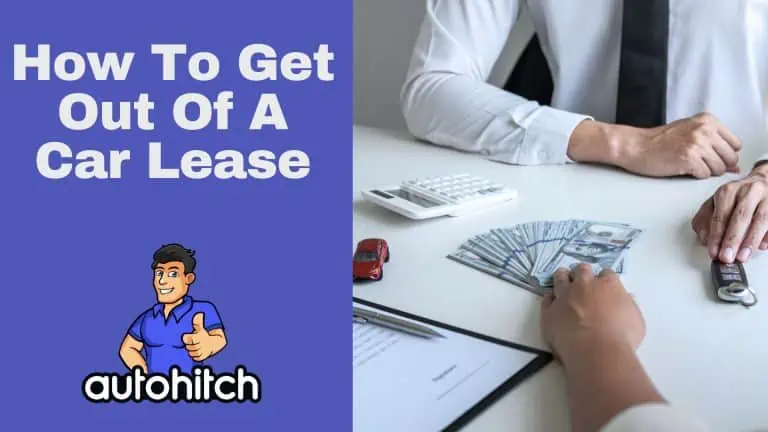Getting Out of a Car Lease Early
When you sign a car lease agreement, you commit to making monthly payments for the duration of the lease term, typically 2-4 years.
However, circumstances can change, don’t they?
You may find yourself needing to get out of the lease early. Here’s a comprehensive guide on how to get out of a car lease before it expires.
Your Options For Getting Out of a Lease
If you want to get out of your car lease early, you generally have three main options:
- Early Lease Termination
- Lease Transfer
- Lease Buyout
- Selling the car to another dealer (Usually same manufacturer)
Let’s explore each option in detail.
1. Early Lease Termination
Early termination is the most straightforward but also the most expensive way to get out of a car lease.
When you terminate the lease early, you are essentially breaking the contract, and the leasing company will charge you a penalty fee.
The early termination fee is usually the remaining payments on the lease plus any applicable fees and charges outlined in your lease agreement. These may include:
Early Lease Termination Fees
- Remaining payments on the lease contract until the end of term
- Early termination fee (Usually the equivalent of 1-2 months payments)
- Disposition fee to cover costs of inspecting and selling the returned vehicle
- Excess wear and tear charges
- Excess mileage charges
To calculate the total cost of early termination, contact your leasing company and request a payoff quote. This quote will provide you with the exact amount you need to pay to terminate the lease early.
Early termination is a viable option if you can no longer afford the lease payments or if the cost of termination is lower than the remaining lease payments.
However, it’s important to note that early termination fees can be substantial, often running into thousands of dollars.
Do Not Walk Away Without Proper Termination
Simply returning the keys or stopping payments is a violation of the lease contract and will severely damage your credit through collections and potential legal action. Properly terminate through the leasing company.
2. Lease Transfer
If the early termination fees are too high, you may consider transferring your lease to another party.
A lease transfer involves finding someone willing to take over your lease payments and responsibilities for the remaining lease term.
How a Lease Transfer Works
- Find a potential buyer (friend, family member, or through a lease transfer service like Swapalease.com).
- The new lessee submits a credit application to the leasing company for approval.
- If approved, the leasing company will prepare the transfer documents for both parties to sign.
- Once signed, the new lessee takes over the lease payments and vehicle possession.
Typical Lease Transfer Fees
Below is a list of the types of fees and amounts you can expect with a lease transfer:
| Fee | Description | Typical Cost |
|---|---|---|
| Transfer/Assignment Fee | Charged by the leasing company to process transferring the lease contract to a new party | $200 – $600 |
| Acquisition/Bank Fee | Administrative fee charged by the leasing company when initiating a new lease contract for the transferee | $395 – $895 |
| Security Deposit | Refundable deposit required by the leasing company from the new lessee to cover potential damages | Equal to 1 month’s payment |
| Vehicle Inspection Fee | Fee for having the vehicle inspected by a third-party service prior to transfer | $100 – $200 |
| Advertising/Marketing Fees | Cost of listing and advertising the lease online or in publications to find a transferee | $50 – $100 |
| Shipping/Transportation Fee | Cost to transport the vehicle to the new lessee’s location if not local | $500 – $1,000 |
Best Lease Transfer Services
| Company | Description |
|---|---|
| QuitALease.com | Online marketplace to list and find parties to take over your lease. Free to list, connects buyers and sellers directly. |
| Swapalease.com | Largest lease transfer marketplace. Has been facilitating online lease transfers since 1999. |
| LeaseTrader.com | Another major lease trading site. Allows you to market your lease to pre-qualified buyers nationwide. |
| Lease Buyout Lenders (Gravity Lending, RefiJet, etc.) | These lenders provide loans to buy out your lease so you can then sell the car. An alternative to transferring the lease itself. |
Most leasing companies charge a transfer fee, which is usually a few hundred dollars. However, this fee is generally lower than the early termination penalty.
It’s important to note that not all leasing companies allow lease transfers, and some may have restrictions, such as not allowing out-of-state transfers or transfers within the last few months of the lease term.
3. Lease Buyout
A lease buyout involves paying the remaining balance on the lease, plus any applicable fees, to purchase the vehicle outright. This option is suitable if you want to keep the car after the lease ends.
The buyout amount is typically the residual value of the vehicle, as stated in your lease agreement, plus any remaining payments and fees. If the market value of the vehicle is higher than the residual value, a buyout may be a favorable option.
Once you’ve paid the buyout amount, you own the vehicle and can choose to keep it or sell it to recoup some of the costs.
4. Selling the to a Dealer
This seems to be one of the best options in a used car market where prices are high. The upside is that you may be able to sell the car for more than the remaining lease payments and buyout price, allowing you to pocket the difference.
How to sell a leased car to another dealer
- Contact dealers of the same brand as your leased car and get appraisals for them to buy out your lease
- You can also try third-party dealers like CarMax, Carvana, etc., but some manufacturers restrict this option
- Compare the offers to your remaining lease payments + residual value to see if you come out ahead
Factors to Consider
When deciding which option is best for getting out of your car lease early, consider the following factors:
- Remaining Lease Term: The closer you are to the end of the lease, the lower the early termination or buyout costs will be.
- Vehicle Condition: If you have excess wear and tear or mileage charges, these fees will be added to the early termination or buyout costs.
- Financial Situation: If you’re experiencing financial hardship, early termination may be the quickest way out, but it’s also the most expensive.
- Future Vehicle Needs: If you plan to lease or purchase another vehicle, a lease transfer or buyout may be more cost-effective in the long run.
Additional Tips
- Read Your Lease Agreement Carefully: Understand the terms and conditions related to early termination, transfers, and buyouts.
- Negotiate with the Leasing Company: Some companies may be willing to waive or reduce certain fees, especially if you have a good payment history.
- Consider Selling the Vehicle: If you choose a buyout, you may be able to sell the vehicle and recoup some of the costs, especially if the market value is higher than the buyout amount.
- Explore Alternative Transportation: If you no longer need a vehicle, consider public transportation, ride-sharing, or other alternatives to avoid the costs of getting out of the lease early.
My Final Thoughts
The option you choose for ending your car lease early depends on your situation. But in most cases, avoiding default or repossession while minimizing out-of-pocket expenses is the best financial decision.
Sources For This Article:
- https://www.creditkarma.com/auto/i/how-to-get-out-of-a-car-lease-early
- https://www.autozen.com/blog/transferring-car-lease
- https://www.realcartips.com/leasing/0437-how-to-get-out-of-lease-early.shtml
- https://www.reddit.com/r/askcarsales/comments/qg9ath/options_for_get_out_of_a_car_lease_early/
- https://www.bankrate.com/loans/auto-loans/acquisition-fee/
- https://www.lexingtonlaw.com/blog/finance/lease-takeover.html



